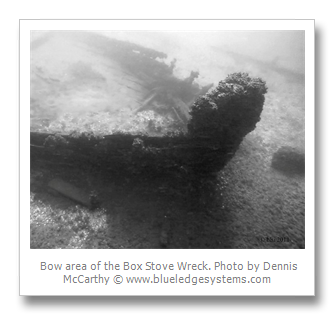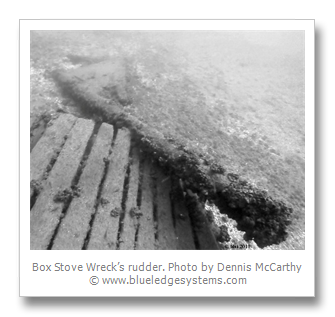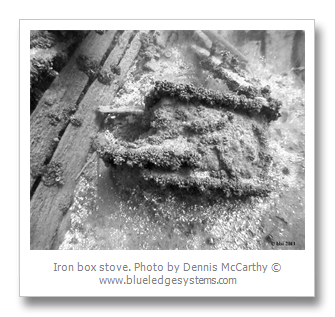I'm not sure why shipwrecks fascinate me. Maybe it's because I watched a boat sink while standing on my parent's beach in Skaneateles, NY when I was twelve years old. A wooden 22-foot ski boat, loaded with 12 passengers, was swamped by its own wake when it was slowing down - thus sending it almost immediately to the 200 foot bottom of the lake. Kathi, my wife, had a similar experience in her early teens. She watched a Donzi powerboat cruising the St. Lawrence in front of her summer home on Beadles Point, when there was a loud noise and a puff of smoke and within minutes, she watched the Donzi as it disappeared from sight. In both instances no one was seriously hurt.
We were both impressed how from one minute to the next, normal life on a boat could be interrupted. What also impressed us was that while we and others watched these sinkings, neither boat was ever recovered or salvaged.
Time just seems to work slower underwater. In the Thousand Islands, one can even dive on a ship built in 1759, the l'Iroquoise, a 250 year old French and Indian military vessel. This is the oldest known shipwreck in the Thousand Islands. Not in great shape but still recognizable for what it was. There are probably 100 other known wreck sites in the area all resting quietly below the surface, slowly fading away.
Well, that was what I was thinking about as I lifted my scuba tank and buoyancy compensator over my head (that technique is very old school and definitely dates me) and I got ready to dive on a new shipwreck. It was a new wreck to us: myself, Kathi, Skip Couch and my diving partner Mike Hughes. There are more years of scuba diving experience between the four of us than I want to think about.
This was a new wreck; one that we had never heard of or dove on before.
We found it by accident using modern technology. We have a hummingbird side imaging sonar unit mounted on our boat. A side imaging sonar is like a depth sounder but looks out to the side of the boat instead of down. It has a transducer that sends out a high frequency narrow pulse of sound. It then records the echoes coming back from objects on the bottom. When all recorded echoes are put together on a display, it provides a picture or image of what's on the bottom.
One day as we traveled between locations recording the bottom, we mistakenly left the sonar on. About a week after this boat trip, I was reviewing the side scan recording on my computer; it was then I realized we had all this extra data. On playing it back, to my surprise there was an image of a shipwreck that we had never seen before.
The side scan image showed a wreck that was about 50 to 60 feet long by about 15 feet wide. There were noticeable objects inside the hull as well as around the wreck. The only way to know what we had was to dive on the site.
We notified New York State Historic Preservation in Albany of the wreck's discovery. They had no previous record of it, so all indications
were it was a new discovery. We were sure that fishermen probably were aware of the site but not its significance.
We had anchored the boat just down current from the wreck site, so that our anchor would not catch and damage the wreck. Kathi and Skip tended the boat while Mike made the dive with me. One last check before getting in the water: air on, knife, fin straps tight, weight belt, straps tight, octopus in holder, BC [buoyancy compensator] connected, dive computer on, gloves on, hood on, boots, suit zipped, hoses clear, mask on, snorkel on left, regulator in month and water open below me, hand on mask and over the side into the water! Underwater camera, oh well, they can hand that from the boat.

Mike was in the water first waiting for me. As the finder of the wreck I got to lead, we started by following the anchor line down. It's an eerie trip from 2011 to somewhere else in time. The water goes from a slight blue to light green and then darker green as you descend. There is nothing to focus on except the anchor line that disappears in the dark distance. Small particles in the water come in and out of focus as your eyes try to lock onto an image. Well, that is what I saw, my dive buddy got to look at me and my bubbles as I descended. From dark to light, the bottom reflects light back at the diver as it comes into view 15 to 20 feet ahead.

Okay, it's back to technical issues. As we descended our neoprene wet suits compress. Every 33 feet down is called an atmosphere - which is an increase in pressure that is the same as going from the surface of the earth to outer space. In scuba diving, atmospheres can add up fast. As our suites compress, we need to add air to our BCs to keep from crashing into the bottom. Add too much air and we're back up to the surface like a balloon. Not a major issue as we have been doing this for years but especially important on this dive.
We do not want to disturbed the bottom and get any mud or silt up in the water that would prevent taking good pictures. Not only must we adjust the buoyancy but we must also keep our fins up above our heads so we don't kick up any mud or silt. This is when it hits you. Floating just feet off the bottom and staring at the bow of a ship you forget that you are in 48 degree water and way below the surface. Hearing only the soothing noise of bubbles ascending from your buddies and your own regulator, you are mesmerized by the view.
You can never anticipate what you will see on the bottom. The wooden hull of the wreck is coated with zebra mussels, hiding detail and disguising its elegance. The bow, absent of any boom or spar, stood erect with a Carvel-built hull curving toward the stern. Planked on the inside, no deck was visible except for a solid box just behind what appeared to be a mast step.

As Mike video taped down one side the wreck, I worked down the other keeping just off the bottom. What was visible was a finely built hull, almost elegant, but it was obvious that parts of the upper portion of the hull were missing. As we approached the stern we saw pieces of railing and the upper parts of the hull all resting as if pulled off to the side by some catastrophic event. The hull’s back quarter was exposed, showing curving upward planks. The decking had collapsed, so we saw the protruding dead wood of the stern post. A large pole with a triangular panel rested just to the side. Lying at the bottom of the hull was an iron stove encrusted in zebra mussels.
To quote my longtime friend Wally Workmaster, “It's like pulling back a curtain to allow a glimpse of what lies behind it.” We had opened the curtain not only on a ship wreck but a story that had been all but lost in time. What is its name, when was it sunk, where was it built and did the crew get off safely? All questions that will be answered in time.
The shipwreck information has been provided to the St. Lawrence River Historical Foundation Inc. (www.srhf.info) which registered the Box Stove Wreck as an underwater archeological site with New York State Department of Historic Preservation. Historic shipwrecks abandoned and embedded in New York State underwater lands belong to the People of the State of New York and are protected by state and federal law from unauthorized disturbance.
Autumn is not the best time to discover a new wreck, as we want to get back there to start putting the pieces of the puzzle back together. However, now it is December we have the winter months to begin our research. Yes, the curtain has begun to rise.
Box Stove Wreck, 53 second by Dennis McCarthy © www.blueledgesystems.com
|
By Dennis McCarthy
Dennis McCarthy retired in 2009 from his professional career in engineering management in the Consumer Electronics and CATV industries. Having traveled to 28 countries in his business profession, he now prefers to spend his time with his wife Kathi living in Cape Vincent, NY and enjoying the Thousand Islands and St. Lawrence River. A certified scuba diver for over 40 years, he made his first dives in the River in 1971. Co-founder of the St Lawrence Historical Foundation [SRHF] in 1993, he helped organized the underwater survey of the Niagara Shoal Wreck which was identified as the French war ship L'Iroquois that sunk in 1761 (See Website) He and his wife Kathi now spend their time with their long time friend Skip Couch promoting Scuba Diving via the Thousand Islands Area Scuba Divers web site www.tiasd.com and by writing and publishing diving guides and shipwreck books.